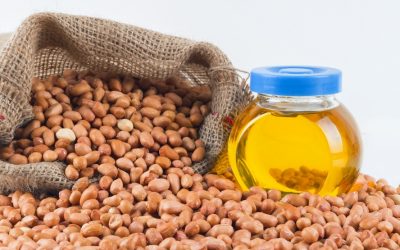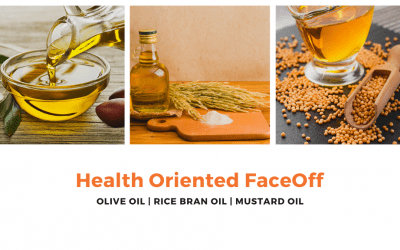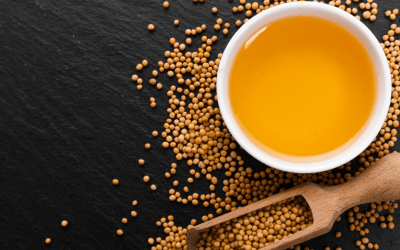Sunflower Oils – Who is the first among the equals?

Golden, light and healthy-sunflower oil is naturally extracted from sunflower seeds and bears a subtle taste. The oils are refined through different processes such as express and solvent refined to make them edible. The Indian Standard (IS 4277:2014) though prescribes different grades of the oil, however, both expressed and refined grade of solvent extracted are recommended for edible purposes. To make the buying decision simpler for consumers, our team had tested 12 sunflower oils brands and ranked them as per the test results.
A Consumer Voice Report
Each brand was evaluated on quality and purity parameters including fatty acid composition, saturated fatty acids, MUFA, PUFA, trans fats, moisture and insoluble impurities, refractive index, acid value, saponification value, unsaponifiable matter among others.
Tested Brands
The tests were conducted at an NABL-accredited laboratory and as per requirements specified in the Food Safety and Standards (FSS) Regulations and Indian Standard IS: 4277-2014 as well as nutritional declarations. Following 12 refined sunflower oil brands packed in 1 litre poly pack were tested. Among the following brands, few brands are regional and have sizable market share in the region. The table below shows which sunflower oil scored highest and in what parameters:
|
Rank |
Total Score Out of 100 (rounded off) |
Brands |
Quantity |
MRP, Rs, |
Best Before, Months |
Manufacturer/ marketer |
|
1 |
93 |
Gemini |
1L (910 gm) |
140 |
9 |
Cargill India Pvt. Ltd. |
|
1 |
93 |
Emami |
1L (910 gm) |
115 |
9 |
Emami Agrotech Limited |
|
2 |
91 |
Dhara |
1L (910 gm) |
115 |
9 |
Mother Dairy Fruit & Vegetable Pvt. Ltd. |
|
2 |
91 |
Fortune |
1L (910 gm) |
125 |
9 |
Adani Wilmar Ltd. |
|
2 |
91 |
Dalda |
1L (910 gm) |
115 |
9 |
Bunge India Pvt. Ltd. |
|
3 |
90 |
Gold Winner |
1L (910 gm) |
104 |
6 |
Kaleesuwari Refinery Private Limited |
|
3 |
90 |
Fresh & Pure |
1L (910 gm) |
120 |
9 |
Future Consumer Limited |
|
3 |
90 |
Freedom |
1L (910 gm) |
105 |
6 |
Gemini Edible & Fats India Pvt. Ltd. |
|
3 |
90 |
Nature Fresh |
1L (910 gm) |
130 |
9 |
Cargill India Pvt. Ltd. |
|
4 |
89 |
Patanjali |
1L (910 gm) |
105 |
9 |
Patanjali Ayurved Limited |
|
5 |
86 |
Sweeker |
1L (910 gm) |
132 |
9 |
Cargill India Pvt. Ltd., |
|
5 |
86 |
Sundrop |
1L (910 gm) |
195 |
9 |
Agro Tech Foods Ltd. |
Note: All the brands claim to be fortified with Vitamin A, D and E. Brand Dalda is imported refined sunflower Oil.
CV Recommendations
Top Performer
Gemini and Emami
Value for Money Brand
Emami
Key findings
• Based on the overall test findings, brands Gemini and Emami secured number one position followed by Dhara, Fortune and Dalda.
• Emami is value for money brand.
• Saturated fats was found lowest in Gemini and Emami.
• In MUFA (healthy fats), Dhara and Sweekar scored highest and Sundrop the lowest.
• In PUFA, (that helps to reduce bad cholesterol), Emami scored highest and Sweekar the lowest.
• All the brands had met the standard requirements and thus found safe for consumption.
• Most of the brands had high difference in their MRP and our purchased price.
• MRP of one litre sunflower oil was between Rs.104 to 195.
• None of the tested brand was found adulterated with cheap oil.
Test results
Fatty Acid Composition | Saturated Fatty Acids| MUFA | PUFA | Trans Fat | Moisture and Insoluble Impurities | Refractive Index | Acid Value| Saponification Value | Unsaponifiable Matter | Iodine Value | Flash Point | Specific Gravity | Per Oxide Value | Argemone Oil | Mineral Oil | Hexane| Packing | Marking | Description | Net Quantity
The oil extracted from the seeds of sunflowers is known as sunflower oil. It has a high quantity of vitamin E, in the form of alpha-tocopherol, which makes it excellent for being used in cooking. It has a high smoking point, which means that sunflower oil holds on to its nutritional content at higher temperatures.
As a form of cooking and frying oil, the high linoleic acid content in sunflower oil is considered to be a desirable constituent. Of course, the linoleic acid also leads to storage problems due to oxidation resulting in off-flavours and rancidity.
Look for the high oleic variety of sunflower oil for deep-frying. High oleic oil is high in monounsaturated fats (MUFA) and has no harmful trans-fat.
Comparative Performance Score
|
Brand Parameter |
Wt. % |
Gemini |
Emami |
Dhara |
Fortune |
Dalda |
|
MRP per litre, Rs. |
|
140 |
115 |
115 |
125 |
115 |
|
Moisture & Insol. impurities |
5 |
4.40 |
4.40 |
4.60 |
4.60 |
4.60 |
|
Saponification value |
7 |
6.68 |
6.89 |
6.36 |
6.42 |
5.74 |
|
Acid value |
6 |
6.00 |
5.10 |
5.70 |
5.70 |
5.70 |
|
Iodine value |
7 |
6.89 |
6.95 |
6.10 |
6.42 |
6.60 |
|
Unsaponifiable matter |
7 |
6.16 |
6.58 |
6.02 |
6.30 |
6.86 |
|
Refractive Index |
7 |
6.38 |
6.33 |
6.44 |
6.28 |
6.44 |
|
Flash point |
5 |
4.84 |
4.84 |
4.88 |
4.80 |
4.90 |
|
Specific gravity |
5 |
4.20 |
4.28 |
4.44 |
4.92 |
3.40 |
|
Per oxide value |
5 |
4.88 |
4.43 |
4.58 |
4.41 |
4.35 |
|
Saturated fatty acid |
7 |
6.38 |
6.33 |
6.16 |
4.45 |
5.32 |
|
MUFA |
10 |
9.72 |
9.64 |
10.0 |
9.47 |
9.82 |
|
PUFA |
8 |
5.87 |
6.51 |
5.14 |
6.33 |
5.84 |
Test Parameters
◆ Fatty Acid Composition
All edible oils have virtually the same fat content but the proportion of different types of fatty acids vary from one type of oil to another. There are unsaturated and saturated fats.
Unsaturated fats are of two kinds MUFA and PUFA. MUFAs lower the bad cholesterol level (LDL) in the blood and increase the good cholesterol (HDL). All the brands were tested for fatty acid composition as per requirement of FSSAI and found within the specified limits. The results of acids detected are given below:
◆ Saturated Fatty Acids
Eating foods that contain saturated fats raises the cholesterol level. Saturated fats raise the HDL cholesterol and change LDL from small, dense (bad) to large LDL. Saturated fat was highest in Sweekar and lowest was in Gemini and Emami.
◆ MUFA (Monounsaturated Fatty Acids)
MUFAs are a healthy type of fat. MUFA and PUFA as per the dietary recommendation helps in biochemical processes associated with nerves, brains,heart, digestion, and cell maintenance. Sunflower oil contains as much as 85 per cent MUFA.MUFAs lower the level of bad cholesterol (LDL) and raise the good cholesterol (HDL). In our test, we found MUFA was highest in Dhara , Sweekar and the lowest in Sundrop.
◆ PUFA (Polyunsaturated Fatty Acids)
PUFA helps reducing bad cholesterol levels thereby lowering heart disease and related diseases. The sources of PUFA include walnuts, sunflower seeds, sesame seeds, peanut butter and peanuts, flaxseed, poppy seed and oil of avocado, olive and sunflower. PUFA was highest in Emami and the lowest we found in Sweekar.
◆ Trans Fat
Just like saturated fats, trans fat also raise the level of bad cholesterol. Trans fat was not detected in any brand of sunflower oil.
◆ Moisture and insoluble impurities
Moisture and insoluble impurities of refined oil shall not be more than 0.1% as per BIS standard. The sunflower oil should be free from any kind of impurities which are insoluble in oil. All the evaluated sunflower oil brands had met the requirement.
|
Gold Winner |
Fresh & Pure |
Freedom |
Nature Fresh |
Patanjali |
Sundrop |
Sweekar |
|
104 |
120 |
105 |
130/95 |
105 |
195 |
132 |
|
4.40 |
4.60 |
4.60 |
4.20 |
4.40 |
4.40 |
4.20 |
|
6.95 |
6.54 |
6.42 |
5.99 |
6.26 |
6.83 |
6.65 |
|
5.10 |
5.70 |
5.70 |
5.10 |
5.70 |
5.70 |
5.70 |
|
6.82 |
6.40 |
6.63 |
6.79 |
6.63 |
6.31 |
6.39 |
|
6.30 |
6.16 |
6.65 |
6.72 |
6.44 |
5.60 |
6.02 |
|
6.28 |
6.50 |
6.33 |
6.38 |
6.38 |
6.44 |
6.38 |
|
4.90 |
4.86 |
4.86 |
4.78 |
4.82 |
4.78 |
4.80 |
|
3.88 |
2.84 |
4.28 |
3.80 |
3.32 |
3.64 |
3.48 |
|
4.72 |
4.40 |
5.00 |
3.43 |
4.95 |
3.91 |
3.32 |
|
4.54 |
5.35 |
3.50 |
5.68 |
3.92 |
5.18 |
3.33 |
|
9.72 |
9.51 |
9.96 |
9.59 |
9.52 |
6.03 |
10.0 |
|
5.85 |
6.50 |
5.08 |
6.43 |
6.08 |
6.21 |
4.81 |
◆ Refractive Index
Refractive index of oil is used to detect rancidity in edible oil. It should be in range of 1.4640-1.4691at 40°C, however for imported oil, it should be between 1.461-1.468. All the brands were within the specified limit. However, brand Fresh & Pure scored highest in this parameter.
◆ Acid Value
According to BIS standard requirements, the acid value should be 0.5 maximum. However, FSS regulation says the acid value level should be at 6.0 maximum. For imported products, the level should be at 4.0 maximum. Acid value indicates the proportion of free fatty acid present in oil. High acid value indicates stale oil stored under improper condition. The acid value of all the brands was found within the limit and Gemini scored highest in this parameter.
◆ Saponification Value
Saponification value helps to detect the presence of other oils/fats. Saponification value of sunflower oil should be between188–194. All the brands were found within the limit and Gold Winner scored highest in this parameter.
◆ Unsaponifiable Matter
Unsaponifiable matter includes those substances which cannot be saponified by caustic treatment, but which are soluble in the normal fat solvents. Unsaponifiable matter should not be more than 1.5 per cent in sunflower oil. All the tested sunflower oil brands were found within the limit. Dalda scored highest in this parameter.
◆ Iodine Value
The iodine value for edible oils is a measure of the un-saturation of fats and oils. Iodine value for sunflower oil should be between 100–145. For imported oil, iodine value should be in the range of118-141. All the tested brands were found within the specified limit in this parameter. Emami scored highest in this parameter.
◆ Flash Point
The flash point of a volatile material is the lowest temperature at which it can vaporize to form an ignitable mixture in air. At the flash point, the vapor may cease to burn when the source of ignition is removed. It shall not be less than 250 o C. Flash point of all the brands was found well above the specified limit. Dalda scored highest in this parameter.
◆ Specific Gravity
Specific gravity of edible oils should be less than 1.00 as they are insoluble in water. In our test, we found, the specific gravity of all the tested sunflower oils was in the range of 0.9145-0.9182. Fortune scored highest in this parameter.
◆ Per Oxide Value
Peroxide value is the most commonly used assay for measuring the state of oxidation in fats and oils. As per the national standard, per oxide value can be maximum at10 meq/kg. Here, all the brands were found within the specified limit. Freedom scored highest in this parameter.
◆ Argemone Oil
Argemone oil is very toxic and may cause eye disease leading to blindness. Regular consumption of it may also cause disease called epidemic dropsy, resembling wet beriberi. Hence, Argemone needs to be absent in sunflower oil. In the evaluation process, we did not find Argemone oil present in any sunflower oil brand.
◆ Mineral Oil
A mineral oil or paraffin oil is any of the various colorless, odorless, light mixtures of higher alkanes which should be absent in edible oils. As we tested the oils on this parameter, we found all the brands were free from this substance. Additionally, no adulteration with cheap oils was detected in any brand.
◆ Hexane
Hexane is used to extract cooking oils from seeds, for cleansing and degreasing a variety of items. It should not be more than 5 ppm. In our test, Hexane was not detected in any brands up to the detection limit of 1.0 ppm.
◆ Packing
As per the standard, the packing of the sunflower oil should be done with food grade packing material. Also, the packing should not affect the oil properties and maintain the shelf life of the product. The tested sunflower oil brands were packed in 1 litter poly pack.
◆ Marking
The labeling information should be clearly and indelibly marked in English or Hindi on the containers:
a) name and trade-mark, type and grade of oil,
b) batch number, month and year of manufacturer,
c) free from argemone oil,
d) nutritional information,
e) best before,
f) net quantity,
g) standard mark if any
h) green dot mark
i) customer care details
j) FSSAI license number
k) MRP. All the brands have given necessary information on their labels.
◆ Description
All the brands were clear and free from rancidity, suspended or other foreign matter, separated water, added colouring or flavouring substances.
◆ Net quantity
According to legal metrology (packaged commodity) rules for 1000-10000 ml tolerance allowed is 1.5 per cent. All the brands were found above the declared quantity.
◆ Conclusion
All the tested brands fulfilled the minimum requirements and can be considered safe for human consumption. Keeping in view the evaluation of test results and overall grading, it can be concluded that most of the brands qualify to be in very good category and can be considered as a safe cooking medium.
Shelf Life
The declared shelf life of all tested brands is in the range of 6 to 9 months. Where the shelf life is six months, there is all the more need for the consumer to be aware, particularly if they are buying the large pack of five litres or higher capacity. They must ensure that the oil remains stable within the consumption period.
How To Best Match Your Oils To Foods
The only way to ensure that you consume healthy oil is by switching between two-three of them – for instance, by using groundnut oil one month and then using sunflower oil/mustard oil in another. Any single oil alone is not preferred.
Blending oils is another option, whereby you take equal proportions of different oils in one container and then use it. This way you do not get prolonged exposure to the side effects of one type of oil and also get the benefits of different oils.
You could also have two or more different kinds of oils in your kitchen which you could use for different purposes. For example, you could use olive oil for salads, groundnut/rice bran oil for frying, and mustard/soybean/sunflower oil for other cooking purposes. This will let you avail of the health benefits offered by each oil brand.
MUFA, PUFA, Saturated Fats and Trans fat
| Monounsaturated | Polyunsaturated | Saturated | Trans |
| Good Fat | Good Fat | Bad Fat | Bad Fat |
| Reduces bad cholesterol (LDL) levels and increases good | Reduces bad cholesterol (LDL) levels | Increases overall cholesterol levels, especially bad cholesterol | Increases the bad cholesterol (LDL) level and decreases good |
| cholesterol (HDL) levels | cholesterol (HDL) levels | ||
| Found in nuts and seeds, avocados, olive oil and canola oil | Found in fatty fish such as salmon, mackerel, trout and sardines, and also in corn, safflower, sunflower and soybean oils |
Found in animal-based foods such as meat, poultry and eggs, and also in butter, cream and other dairy products Also found in plant-based products such as coconut, coconut oil, palm oil and palm kernel oil, and cocoa butter |
Found in hydrogenated fat products such as margarines and vegetable shortenings Used in packaged snack foods such as cookies, crackers and chips, and in fried foods |
Related
Groundnut Oils-Your search for a no cholesterol oil ends here
Off late consumers have turned extra careful about the food and food ingredients intake. If you’re one of us, you will feel relived with this piece...
The Health-Oriented Faceoff : Mustard Oil vs. Rice Bran Oil vs. Olive Oil
Health fads have become an inseparable part of people’s lives today. People are always looking for something that will help improve their health...
How to Increase the Shelf Life of Mustard Oil?
Mustard Oil is one of the common Indian kitchen ingredients that cannot be replaced. Its unique and pungent flavor, and its ability to make foods...



